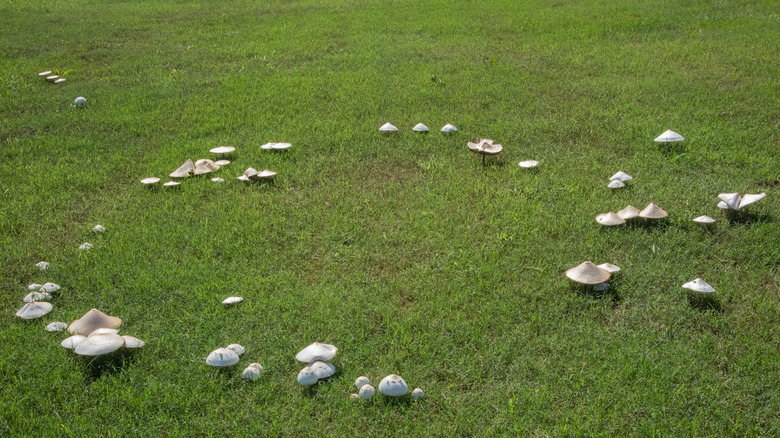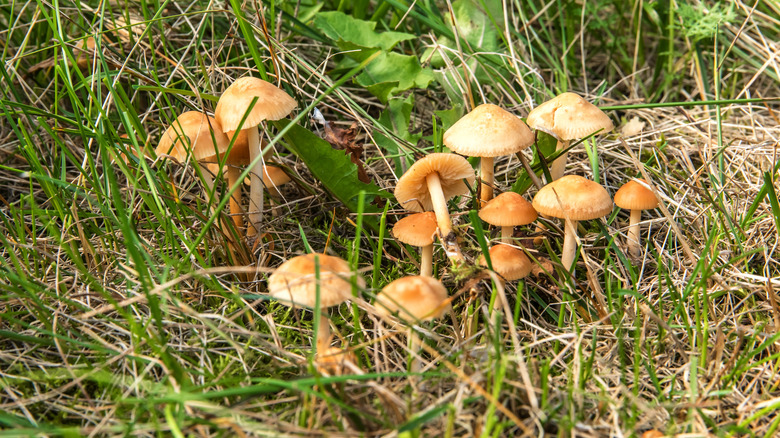What Causes A Fairy Ring In Your Lawn And What Can You Do About It?
In your quest to cultivate a healthy lawn, you might stumble upon a fascinating yet perplexing sight: a pattern known as a "fairy ring." Often found in lawns and open grassy areas, this eye-catching spectacle takes the form of a circular or semi-circular formation of mushrooms or an unusually lush, dark green patch of grass. This distinctive occurrence, which may initially appear surreal or otherworldly, is far from being an enigma or a figment of folklore. Instead, it's a tangible manifestation of nature's intricate processes at work, governed by a particular family of fungi that inhabits the very soil under your lawn's green blanket.
These fungi, primarily members of the Basidiomycete class, engage in a peculiar growth pattern that creates an interesting yet often challenging phenomenon for lawn enthusiasts. As intriguing as they are, fairy rings are not just benign natural wonders. They can be problematic for your lawn's health and aesthetics. Let's look at the intricate causes behind these enchanting fairy rings and practical strategies to tackle them, transforming this challenge into an opportunity to enhance your gardening prowess and maintain your lawn's health and beauty.
Understanding the cause of fairy rings
Beginning with an initial fungal spore, the fungi proliferate, growing and spreading in an outward direction, following a radial pattern. This is how a fairy ring is developed. During this expansion, the fungus harnesses the organic matter in the soil, decomposing it to release nutrients. This surge of nutrients invigorates the grass above, causing it to grow more quickly and adopt a darker green hue.
However, the nutrient boost and lush growth aren't the only impacts of the fungal activity. As the fungus grows, it also forms a dense, compact network of mycelium — the vegetative part of the fungus made up of hyphae. While vital for the fungus, this mycelium network can be detrimental to your lawn. It forms an impermeable barrier in the soil, preventing water and essential nutrients from reaching the roots of the grass. The unfortunate consequence is the often-noticed wilting and browning of the grass above the ring, creating a stark contrast between the lush, green circle of grass and the inner patch of dying grass — the classic fairy ring appearance.
Further enhancing the spectacle, mushrooms may grow along the ring, especially after rainfall. Though often regarded as an annoyance, these mushrooms play a crucial role in the fungal life cycle. They are the reproductive structures of the underground fungus, serving as vessels for spore dispersal. Their job is to release these spores into the environment, ensuring the perpetuation of the fungus and potentially seeding future fairy rings.
Dealing with fairy rings in your lawn
There are multiple strategies to tackle the appearance and impact of fairy rings on your lawn. One such method is to camouflage their presence. Regular watering, fertilizing, and aeration of your lawn help maintain its overall health, which in turn minimizes the visual impact of the fairy ring. In some instances, removing the mushrooms as they appear can limit the spread of the fungus and curtail the development of new fairy rings.
However, if the fairy ring is causing significant damage, leading to areas of dying grass, you may need to contemplate more drastic interventions. One such measure could involve excavating the affected area of the lawn, extending to about 300mm inside the fairy ring. This procedure allows you to physically break up the mycelium's dense network and disrupt its growth. Once the mycelium is broken up, you can replace the soil with fresh, nutrient-rich soil to give your lawn a healthy new start.
In more severe cases, when other methods seem insufficient, you might need to consider treatments with fungicides. These chemical agents are specifically designed to control or kill fungi and can be effective against the fairy ring fungus. However, it's worth noting that these treatments are typically considered as a last resort. Fungicides can impact the environment, affecting your soil's target fungus and other beneficial microorganisms. Therefore, it's essential to use these treatments judiciously and ideally under the guidance of a lawn care professional.


